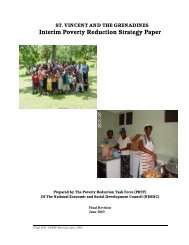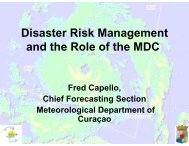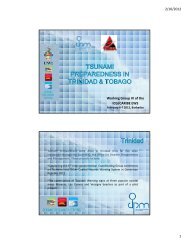The Anatomy of A Silent Crisis The Anatomy of A Silent Crisis
The Anatomy of A Silent Crisis The Anatomy of A Silent Crisis
The Anatomy of A Silent Crisis The Anatomy of A Silent Crisis
- TAGS
- anatomy
- www.bb.undp.org
You also want an ePaper? Increase the reach of your titles
YUMPU automatically turns print PDFs into web optimized ePapers that Google loves.
98 Forum 2009: Climate Change – <strong>The</strong> <strong>Anatomy</strong> <strong>of</strong> a <strong>Silent</strong> <strong>Crisis</strong><br />
to climate change based on assumptions described in<br />
“Notes on report methodology.” Centre for Research on<br />
the Epidemiology <strong>of</strong> Disasters Database, (2009).<br />
19. Barnett, J. and Adger, N. (2001): “Climate dangers and<br />
Atoll countries.” Tyndall Centre for Climate Change<br />
Research, Working Paper 9. http://www.tyndall.ac.uk/<br />
publications/working_papers/wp9.pdf.<br />
20. Comprehensive regional and global assessment<br />
<strong>of</strong> mortality and disability conducted by the World<br />
Health Organization. It can be viewed as the gap<br />
between current health status and an ideal situation in<br />
which everyone lives into old age free <strong>of</strong> disease and<br />
disability. Causes <strong>of</strong> the gap are premature mortality,<br />
disability and exposure to certain risk factors that<br />
contribute to illness, such as climate change. Please<br />
refer to “Notes on report methodology C.”<br />
21. WHO. (2004): “<strong>The</strong> global burden <strong>of</strong> disease: 2004<br />
update.” World Health Organization Health statistics<br />
and health information systems. http://www.who.<br />
int/healthinfo/global_burden_disease/2004_report_<br />
update/en/index.html.<br />
22. Based on and adapted from CRED and ISDR (2008),<br />
McMichael, A.J., et al (2004) and Kron, W. (2009).<br />
Please see “Notes on report methodology” to<br />
describe the estimation in more detail.<br />
23. A 320% increase in weather related disasters today<br />
is assumed based on Webster, M., et al. (2008). A<br />
50% climate change attribution from weather related<br />
disasters is assumed in 2030. Webster, M., et al.<br />
(2008): “<strong>The</strong> Humanitarian Costs <strong>of</strong> Climate Change.”<br />
Feinstein International Center, December, p.19.<br />
24. Total estimate consists <strong>of</strong> the total number <strong>of</strong> people<br />
affected by gradual environmental degradation and<br />
weather-related disasters attributable to climate<br />
change. Please see “Notes on report methodology” to<br />
describe the estimation in more detail.<br />
25. <strong>The</strong> total number <strong>of</strong> people with diabetes is projected<br />
to rise from 171 million in 2000 to 366 million in 2030.<br />
International Diabetes Federation. (2009). “Diabetes<br />
Prevalence.” International Diabetes Federation.<br />
http://www.idf.org/home/index.cfm?node=264 and<br />
Wild, S., et al. (2004): “Global prevalence <strong>of</strong> diabetes”.<br />
Diabetes Care, Volume 27, Number 5, May. http://<br />
www.who.int/diabetes/facts/en/diabcare0504.pdf.<br />
26. For deaths due to weather related disasters, this<br />
assumes a 160% increase in the number <strong>of</strong> deaths<br />
for a 320% increase in the number <strong>of</strong> disasters. For<br />
deaths due to gradual environmental degradation see<br />
WHO. (2004): “<strong>The</strong> global burden <strong>of</strong> disease: 2004<br />
update.” World Health Organization Health statistics<br />
and health information systems, p.56.<br />
http://www.who.int/healthinfo/global_burden_<br />
disease/2004_report_update/en/index.html<br />
27. WHO (2004) estimated that 519,000 people died from<br />
breast cancer in 2004.<br />
28. Webster, M., et al. (2008): “<strong>The</strong> Humanitarian Costs<br />
<strong>of</strong> Climate Change.” Feinstein International Center,<br />
December, p.19.<br />
29. This value is obtained applying a 50% attribution <strong>of</strong><br />
climate change, which is based on the difference in<br />
the trend increase in the frequency <strong>of</strong> weather related<br />
disasters and geophysical disasters. We use Munich<br />
Re (2009) trend calculations and extrapolate the linear<br />
trend to 2030. <strong>The</strong> calculation is explained in “Notes<br />
on report methodology”.<br />
30. Parry, M., Rosenzweig, C., and Livermore, M. (2005):<br />
“Climate Change, Global Food Supply and Risk <strong>of</strong><br />
Hunger.” Philosophical Transactions <strong>of</strong> the Royal<br />
Society, 360, 2125-2138.<br />
31. WHO. (2008): “Protecting Health From Climate<br />
Change”. <strong>The</strong> World Health Organization-World<br />
Health Day 2008. http://www.who.int/world-healthday/toolkit/report_web.pdf.<br />
32. Grinsted, A., Moore, J.C., and Jevrejeva, S. (2009):<br />
“Reconstructing sea level from paleo and projected<br />
temperatures 200 to 2100 AD.” Climate Dynamics,<br />
10.1007/s00382-008-0507-2, January 6, p.1. and<br />
UFL. (2009): “A White Paper on the Impacts <strong>of</strong> Climate<br />
Change on Drylands.” Department <strong>of</strong> Geography-<br />
University <strong>of</strong> Florida, p.3.<br />
http://www.clas.ufl.edu/lueci/southworth/Climate-<br />
Change-Class/chien/CWKAO_White%20paper1.pdf.







